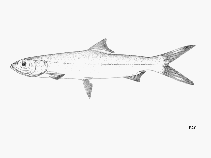Elops lacerta Valenciennes, 1847
West African ladyfish
Adicionar as suas observações no Fish Watcher
| Native range | All suitable habitat | Point map | Year 2050 |

|
| This map was computer-generated and has not yet been reviewed. |
| Elops lacerta AquaMaps Data sources: GBIF OBIS |
Adicionar o seu Fotografias e vídeos
Pictures | Imagem do GoogleElops lacerta
Picture by FAO
Pictures | Imagem do GoogleElops lacerta
Picture by FAO
Classificação / Names Nomes comuns | Sinónimos | Catalog of Fishes(Género, Espécies) | ITIS | CoL | WoRMS | Cloffa
> Elopiformes (Tarpons and tenpounders) > Elopidae (Tenpounders)
Etymology: Elops: Greek, ellops = a kind of serpent (Ref. 45335).
More on author: Valenciennes.
Etymology: Elops: Greek, ellops = a kind of serpent (Ref. 45335).
More on author: Valenciennes.
Environment: milieu / climate zone / depth range / distribution range Ecologia
marinhas; Água doce; estuarina; intervalo de profundidade 1 - 50 m (Ref. 26999). Tropical; 21°N - 29°S, 20°W - 15°E
Distribuição Países | Áreas FAO | Ecossistemas | Ocorrências | Point map | Introduções | Faunafri
Eastern Atlantic: coastal waters of West Africa from Mauritania to Angola or Namibia (Ref. 4445, 81265, 81629). Sometimes it enters freshwater, like in Cross River and Kouilou-Niari River (Ref. 81629). It is often confused with Elops senegalensis (Ref. 81629).
Tamanho / Peso / Idade
Maturity: Lm ? range ? - ? cm
Max length : 100.0 cm TL macho/indeterminado; (Ref. 5377); common length : 60.0 cm TL macho/indeterminado; (Ref. 2683)
Max length : 100.0 cm TL macho/indeterminado; (Ref. 5377); common length : 60.0 cm TL macho/indeterminado; (Ref. 2683)
Descrição breve Chaves de identificação | Morfologia | Morfometria
Espinhos dorsais (total) : 0; Espinhos anais: 0. Diagnosis: Elops lacerta is characterized by 17-19 gill-rakers on lower limb of first gill arch and small scales, those in lateral line numbering 72 to 83 and ornamented with a small, unbranched, tubule (Ref. 2844, 81265, 81629).
Elops lacerta lives in shallow coastal waters over sandy/muddy bottoms, occasionally entering brackish waters and the lower reaches of rivers; from inshore and some way up tidal rivers to edge of shelf (Ref. 4445, 81265, 81629). The reproduction takes place in the sea (Ref. 81265). It feeds primarily on small fishes, mainly clupeids, crustaceans and molluscs; large specimens also feed on insects (Ref. 81629).
Life cycle and mating behavior Maturidade | Reprodução | Desova | Ovos | Fecundidade | Larvas
Referência principal
Upload your references | Referências | Coordenador | Colaboradores
Whitehead, P.J.P., 1990. Elopidae. p. 118-119. In J.C. Quero, J.C. Hureau, C. Karrer, A. Post and L. Saldanha (eds.) Check-list of the fishes of the eastern tropical Atlantic (CLOFETA). JNICT, Lisbon; SEI, Paris; and UNESCO, Paris. Vol. 1. (Ref. 4445)
Categoria na Lista Vermelha da IUCN (Ref. 130435: Version 2024-2)
Preocupação menor (LC) ; Date assessed: 07 April 2020
CITES
Not Evaluated
Ameaça para o homem
Harmless
Utilização humana
Pescarias: espécies comerciais; peixe desportivo: sim
FAO - pescarias: landings; Publication: search | FishSource | Sea Around Us
Mais informação
Population dynamics
Parâmetros de crescimento
Max. ages / sizes
Length-weight rel.
Length-length rel.
Frequência de comprimento
Mass conversion
Recrutamento
Abundância
Parâmetros de crescimento
Max. ages / sizes
Length-weight rel.
Length-length rel.
Frequência de comprimento
Mass conversion
Recrutamento
Abundância
Life cycle
Reprodução
Maturidade
Maturity/Gills rel.
Fecundidade
Desova
Spawning aggregations
Ovos
Desenvolvimento dos ovos
Larvas
Dinâmica larvar
Reprodução
Maturidade
Maturity/Gills rel.
Fecundidade
Desova
Spawning aggregations
Ovos
Desenvolvimento dos ovos
Larvas
Dinâmica larvar
Anatomy
Área branquial
Brain
Otolith
Área branquial
Brain
Otolith
Physiology
Body composition
Nutrients
Consumo de oxigénio
Tipo de natação
Velocidade de natação
Visual pigments
Fish sound
Diseases & Parasites
Toxicity (LC50s)
Body composition
Nutrients
Consumo de oxigénio
Tipo de natação
Velocidade de natação
Visual pigments
Fish sound
Diseases & Parasites
Toxicity (LC50s)
Genetics
Genética
Heterozygosity
Hereditariedade
Genética
Heterozygosity
Hereditariedade
Human related
Aquaculture systems
Perfis para aquacultura
Estirpes
Ciguatera cases
Stamps, coins, misc.
Aquaculture systems
Perfis para aquacultura
Estirpes
Ciguatera cases
Stamps, coins, misc.
Ferramentas
E-book | Guia de campo | Chaves de identificação | Ferramenta auxiliar de frequências de comprimento | Ferramenta sobre a história de vida | Mapa dos pontos | Classification Tree
| Catch-MSY |
Relatórios especiais
Descarregue XML
Fontes da internet
AFORO (otoliths) | Aquatic Commons | BHL | Cloffa | BOLDSystems | Websites from users | Consultar FishWatcher | CISTI | Catalog of Fishes: Género, Espécies | DiscoverLife | ECOTOX | FAO - pescarias: landings; Publication: search | Faunafri | Fishipedia | Fishtrace | GenBank: genoma, nucleotídeo | GloBI | Google Books | Google Scholar | Google | IGFA World Record | MitoFish | Otolith Atlas of Taiwan Fishes | PubMed | Reef Life Survey | Socotra Atlas | Árvore da vida | Wikipedia: ir para, procurar | World Records Freshwater Fishing | Zoobank | Registo zoológico
Estimates based on models
Preferred temperature (Ref. 123201): 23.8 - 28, mean 26.7 °C (based on 68 cells).
Phylogenetic diversity index (Ref. 82804): PD50 = 0.5176 [Uniqueness, from 0.5 = low to 2.0 = high].
Bayesian length-weight: a=0.00646 (0.00487 - 0.00856), b=2.97 (2.89 - 3.05), in cm total length, based on LWR estimates for this species (Ref. 93245).
Nível Trófico (Ref. 69278): 4.2 ±0.75 se; based on food items.
Resiliência (Ref. 120179): Médio, tempo mínimo de duplicação da população 1,4 - 4,4 anos (Assuming tm=2-3; K=0.7 for juveniles).
Prior r = 0.57, 95% CL = 0.37 - 0.85, Based on 1 data-limited stock assessment.
Fishing Vulnerability (Ref. 59153): High vulnerability (60 of 100).
Climate Vulnerability (Ref. 125649): Very high vulnerability (83 of 100).
Nutrients (Ref. 124155): Calcium = 100 [59, 207] mg/100g; Iron = 1.23 [0.71, 2.15] mg/100g; Protein = 17.2 [14.7, 20.3] %; Omega3 = 0.197 [0.105, 0.378] g/100g; Selenium = 63.3 [29.7, 146.8] μg/100g; VitaminA = 8.36 [3.04, 23.05] μg/100g; Zinc = 0.981 [0.695, 1.430] mg/100g (wet weight);




